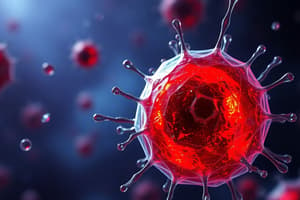Podcast
Questions and Answers
In follicular lymphoma, the overexpression of BCL-2 prevents apoptosis, leading to increased cell survival. Which of the following mechanisms best describes how BCL-2 achieves this?
In follicular lymphoma, the overexpression of BCL-2 prevents apoptosis, leading to increased cell survival. Which of the following mechanisms best describes how BCL-2 achieves this?
- By inhibiting the release of cytochrome C from the mitochondria, thus preventing apoptosome formation. (correct)
- By directly activating caspases, initiating the caspase cascade and promoting cell breakdown.
- By directly interacting with death receptors, such as Fas and TNF receptors, to initiate the extrinsic apoptotic pathway.
- By promoting the formation of apoptotic bodies, facilitating the engulfment of cellular debris by macrophages.
A researcher is investigating potential therapeutic targets for neurodegenerative diseases characterized by abnormal protein accumulation. Based on the information provided, which of the following strategies would be most effective in promoting the removal of damaged cells?
A researcher is investigating potential therapeutic targets for neurodegenerative diseases characterized by abnormal protein accumulation. Based on the information provided, which of the following strategies would be most effective in promoting the removal of damaged cells?
- Upregulation of TNF-alpha to directly induce necrosis.
- Overexpression of BCL-2 to enhance cell survival and prevent apoptosis.
- Inhibition of caspase-3 to prevent the execution of apoptosis.
- Knockdown of BCL-2 to promote cytochrome C release and caspase activation. (correct)
During a study of liver pathology, a pathologist observes a liver biopsy from a patient with viral hepatitis. Which specific set of morphological features would the pathologist expect to see in hepatocytes undergoing apoptosis?
During a study of liver pathology, a pathologist observes a liver biopsy from a patient with viral hepatitis. Which specific set of morphological features would the pathologist expect to see in hepatocytes undergoing apoptosis?
- Cellular swelling, karyolysis, and neutrophil infiltration.
- Cellular shrinkage, basophilic cytoplasm, and extensive inflammation.
- Pyknosis, eosinophilic cytoplasm, and karyorrhexis. (correct)
- Karyolysis, cytoplasmic fragmentation, and loss of membrane integrity.
A researcher is comparing the intrinsic and extrinsic pathways of apoptosis. Which statement correctly differentiates the key initiating events of these two pathways?
A researcher is comparing the intrinsic and extrinsic pathways of apoptosis. Which statement correctly differentiates the key initiating events of these two pathways?
During apoptosis, specific enzymes dismantle the cell in a highly regulated manner. What is the critical role of caspase-3 in this process?
During apoptosis, specific enzymes dismantle the cell in a highly regulated manner. What is the critical role of caspase-3 in this process?
Macrophages recognize and phagocytose apoptotic bodies through specific signals. Which signal is primarily responsible for targeting apoptotic cells for engulfment by macrophages?
Macrophages recognize and phagocytose apoptotic bodies through specific signals. Which signal is primarily responsible for targeting apoptotic cells for engulfment by macrophages?
A researcher induces apoptosis in a cell culture and observes distinct morphological changes. Which of the following features is exclusively associated with necrosis and not observed in apoptosis?
A researcher induces apoptosis in a cell culture and observes distinct morphological changes. Which of the following features is exclusively associated with necrosis and not observed in apoptosis?
In a scenario where BCL-2 is knocked down in a cell, which sequence of morphological events would be expected to occur as the cell undergoes apoptosis?
In a scenario where BCL-2 is knocked down in a cell, which sequence of morphological events would be expected to occur as the cell undergoes apoptosis?
Apoptosis is crucial in various physiological processes. Which of the following exemplifies a physiological role of apoptosis?
Apoptosis is crucial in various physiological processes. Which of the following exemplifies a physiological role of apoptosis?
Compared to necrosis, what crucial aspect of membrane integrity differentiates apoptosis as a 'clean' form of cell death?
Compared to necrosis, what crucial aspect of membrane integrity differentiates apoptosis as a 'clean' form of cell death?
Flashcards
Apoptosis
Apoptosis
Programmed cell death, distinct from necrosis, involving caspase activation and controlled self-destruction.
Caspase Cascade
Caspase Cascade
Enzymes activated during apoptosis, leading to controlled cell death without inflammation.
Intrinsic Pathway
Intrinsic Pathway
Apoptotic pathway triggered by intracellular signals and mitochondrial changes.
Extrinsic Pathway
Extrinsic Pathway
Signup and view all the flashcards
BCL-2
BCL-2
Signup and view all the flashcards
Pyknosis
Pyknosis
Signup and view all the flashcards
Karyorrhexis
Karyorrhexis
Signup and view all the flashcards
Karyolysis
Karyolysis
Signup and view all the flashcards
Membrane Blebbing
Membrane Blebbing
Signup and view all the flashcards
Apoptotic Bodies
Apoptotic Bodies
Signup and view all the flashcards
Study Notes
- Apoptosis is a form of cell death where cells "fall off"
- It is essential to understand its causes, mechanisms, and morphological features, as well as how it differs from necrosis.
Apoptosis vs. Necrosis
- Apoptosis is a clean cell death that does not cause inflammation, while necrosis is associated with inflammation.
- Irreversible cell injury can lead to either necrosis or apoptosis
Apoptotic Mechanisms
- Apoptosis can occur through two main routes: the intrinsic (mitochondrial) pathway and the extrinsic (death receptor) pathway.
Intrinsic Pathway
- The intrinsic pathway is mitochondrial
- BAX and BAK, which are part of the BCL-2 family, allow cytochrome C to exit the mitochondria and bind to Apaf-1, forming an apoptosome.
- The apoptosome cleaves pro-caspase-9 to caspase-9 that triggers caspase-3, activating the caspase cascade and leading to cell breakdown.
BCL-2
- BCL-2 is an anti-apoptotic mitochondrial protein that promotes cell survival.
- Overexpression of BCL-2 occurs in follicular lymphoma, preventing apoptosis and promoting cell survival.
Extrinsic Pathway
- The extrinsic pathway involves death receptors like Fas and TNF receptors.
- T cells interact with infected cells via these receptors to induce apoptosis.
Caspase Cascade
- Caspase-9 and caspase-3 are involved in the caspase cascade.
- TNF alpha induces apoptosis by extrinsic pathway
Morphological Changes
- Nuclear chromatin condensation and nuclear shrinkage is called pyknosis
- Nuclear fragmentation is called karyorrhexis
- Pyknosis and karyorrhexis are present in both apoptosis and necrosis
- Karyolysis (fading away of the nucleus) is seen only in necrosis
- Apoptosis involves membrane blebbing and cytoplasmic fragmentation, forming apoptotic bodies.
- Phospholipids are released as "eat me" signals that initiate macrophages to phagocytose apoptotic bodies.
Causes of Apoptosis
- Physiologic apoptosis is seen in aging cells
- Pathologic apoptosis is seen in viral hepatitis
- In viral hepatitis, apoptotic cells show pyknotic, shrunken nuclei with eosinophilic cytoplasm
Morphological Differences: Apoptosis vs. Necrosis
- Apoptosis features include pyknosis, karyorrhexis, and apoptotic bodies,
- Necrosis features include karyolysis, membrane rupture, and inflammation.
BCL-2 Knockdown
- Knocking down BCL-2 promotes apoptosis, leading to chromatin condensation and fragmentation.
Membrane Integrity
- In apoptosis, the cell maintains membrane integrity, forming apoptotic bodies without leakage.
- In necrosis, membrane integrity is lost, leading to cytoplasmic spilling and inflammation.
Key Terms
- Apoptosis - Cell death
- Caspase Cascade - Enzymes that clean the cell with no inflammation
- Intrinsic Pathway - Mitochondrial activity
- Extrinsic Pathway - Utilizes death receptors
Quiz Answers
- BCL-2 prevents apoptosis by inhibiting cytochrome C release from mitochondria, thus blocking apoptosome formation (Answer: C).
- Knockdown of BCL-2 promotes cytochrome C release and caspase activation, which can remove damaged cells (Answer: B).
- Hepatocytes undergoing apoptosis in viral hepatitis exhibit pyknosis, eosinophilic cytoplasm, and karyorrhexis (Answer: C).
- The intrinsic pathway is primarily triggered by intracellular signals, leading to mitochondrial changes, while the extrinsic pathway is initiated by extracellular ligands binding to death receptors (Answer: B).
- Caspase-3 executes the breakdown of cellular organelles and the cytoskeleton, leading to the formation of apoptotic bodies (Answer: A).
- Externalization of phospholipids on the cell surface serves as an 'Eat me' signal for macrophages to recognize and phagocytose apoptotic bodies (Answer: D).
Studying That Suits You
Use AI to generate personalized quizzes and flashcards to suit your learning preferences.



